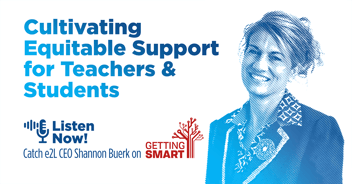Teacher Wellness Matters, Period
We have a saying at engage2learn: “When teachers thrive, students thrive.” Therefore, we pay a lot of attention to what our partners are working on and how we can align our services to support them. During this pandemic, there has been substantial emphasis on student mental health and wellness. The focus has been not only on keeping kids physically well through social distancing, cleaning, and mask-wearing but also emotionally supported and connected through social-emotional learning (SEL) and counseling to avoid the ramifications of isolation. District and campus administrators spend time and money on programming to improve in these areas, but what is being done to support teacher wellness?
How can we survive as a public education system without a concentrated, intentional focus on the overall well-being of our teachers? We’re pretty diligent as a system at focusing on what teachers need to improve. The narrative surrounding the capacity and effectiveness of teachers is largely negative. If you believe everything you read, the neighborhood public school is just a giant, hot mess of failure and inadequacy.
At engage2learn, we do not believe this particular narrative, as it is our greatest privilege to work alongside amazing educators every single day. Our partnership with them allows us to see their hearts and recognize the Herculean efforts they put forth daily to rise to the occasion before them. Our partnership also allows us to see the weight and impact on each individual’s mental, emotional, and physical health. We recognize the need to bolster support for teacher wellness that will, in turn, positively impact the public education system as a whole.
In his recent book, WHOLE: What Teachers Need to Help Students Thrive, Rex Miller asserts schools are becoming more like field hospitals. Teachers, he says, are the front line workers who are experiencing significant trauma as a result of their daily expectations and the schedule that this expectation forces on them. Miller references a 2018 Gallup Teacher Wellbeing Index study that asserts 67% of teachers and 80% of administrators work under high stress. I’m sure these numbers will be much higher for 2020. These levels of stress cause teaching to be in the top four most stressful professions. It’s no wonder teachers are leaving the profession at an alarmingly high rate!
Considering the extraordinary circumstances presented this past year, as well as all of the changes and rapid evolution of circumstances thrust upon educators, how can we expect teachers to remain in this crucible of a profession without a concerted effort to ensure they are well? If teachers are not well, are we ready to deal with the lasting impact on students who spend so much time with those same teachers? If we don’t start to be incredibly intentional about how we support, encourage, and care for our teachers, the price we will all have to pay will be more than we can imagine.
There are numerous articles and blogs out there that inform teachers on how to manage their own self-care. All of those recommendations are framed as ways a teacher can take care of themselves. Concepts such as breathing techniques, keeping a gratitude journal, eating healthy foods, maintaining work/life balance, etc., are encouraged to help teachers manage stress and well-being. However, there isn’t much specific discussion about what the system should do to intentionally support the wellness of the educators that the same system relies on to DO. ALL. THE. THINGS. The problem of not focusing on this topic is that we are already facing an impending teacher shortage (see my recent blog on teacher attrition), and what is happening today is going to exponentially accelerate this process. While this blog certainly doesn’t profess to present all of the answers, there are a few key things that system leaders should consider immediately … before it is too late.
3 Ways to Support Teacher Wellness in Any Context
Be Mindful
No, I’m not suggesting that school leaders need to begin a personal mindfulness practice (although that’s not a bad idea). I’m suggesting campus and district leaders be mindful of the entire picture of a teacher’s life. Part of relationship building is understanding the other person. Every administrator should be diligent in the pursuit of understanding the teachers he or she is serving. Building in time to completely understand what aspects of life a teacher is responsible for outside of the school building is essential to providing the best possible support for each individual. Does the teacher have kids? Does the teacher have elderly parents to care for? What kinds of activities is the teacher or the teacher’s family involved in outside of school?
These are simple enough questions, but answering them helps complete the picture of the teacher in a way that then allows the leader to better lead. One easy suggestion is to encourage the teacher to set boundaries so that their work-life doesn’t completely take over and make any other aspect of their lives shrivel up from neglect. We, as leaders, have to create the belief that these boundaries are important and okay. We can also manage what is expected of teachers to be able to actually accomplish within those boundaries. This respect for living outside of the school day, or even just the expression that we understand that life outside of school exists, can improve a teacher’s sense of overall wellness.
Provide Just-Right Support
In my recent blog about teacher attrition, I also suggested ways to provide intentional support for teachers so they would want to remain in the profession and a part of your campus or district. Ultimately, it isn’t just about how much support you provide, but more importantly, providing exactly the right support and resources. This goes way beyond providing donuts in the lounge. Teachers, as a part of their overall wellness, like anyone else, want to feel successful. Providing them the exact right resources that align with their efforts and help them to be successful is the goal. We believe that coaching is one key source of support that just can’t be matched. The resources found in our eSuite© platform provide an incredibly robust repository of rubrics, resources, tools, and templates — all aligned to our curated, research-based best practices — that save teachers time. Saving a teacher’s time and reducing the pressure to get so much done in so little available time will go a long way to encourage the teacher’s belief that he or she can get it all done.
Create Culture
Leadership matters, and it matters most in the creation of culture. We love working with district leaders who really understand that everything they do either builds the culture that leads to success or … well … it doesn’t. There isn’t much that lands in the neutral effect category. If we’re going to be intentional about caring for teachers, then we have to be intentional in creating a culture that values the conditions that support a teacher’s overall sense of well being. This fact cannot be understated. A leader has the capacity to create the culture that actually improves a teacher’s overall sense of well-being and, equally true, a leader can create a culture that decreases a teacher’s overall sense of well-being. So, leaders, it is up to us to make sure that we do the right things in the right way. There are so many potential benefits that it just makes sense to put this on our top priority list. A couple of easy critical moves that you can do without any need for additional funds are:
- Provide a place for people to go. This can manifest in more than one way, but one easy thing to do is provide a lounge area that is free from work-related opportunities. Sometimes people just need a minute to catch their breath, and providing a space for just that is pretty easy to do.
- Provide the opportunity to talk. This could be the opportunity to talk with you as the leader, or it could be a system of relationships you establish between colleagues. At e2L, we call this our Better Together Partners (BTPs), meaning they are our person in the organization that we can go to and intentionally try to make connections with over the course of the year. The opportunity to talk, debrief stressors, offload secondary trauma, etc., is critical to not confining all of that emotion inside, causing significant negative consequences to our overall health.
- Be smart about expectations. As referenced in The ONE Thing by Gary Keller and Jay Papasan, establish the “One Thing” that makes everything else easier or unnecessary so as not to overwhelm and confuse. Leaders are feeling a lot of pressure and stress too, and it is easy to fall into the trap of activity and initiative. Adding duplicitous or contradictory tasks or initiatives to a culture can have a disastrous impact on our sense of wellness. When we add complexity, we often add confusion and reduce the sense of self-efficacy, both of which make it difficult to remain positive. The less positive we are, the greater the negative impact on our overall wellness.
Conclusion
Your campus or district is full of people, both teachers and leaders, who desire to do everything in their power to transform the lives of the students they serve each and every day. There are limits to human capacity, however, to shoulder the weight of that task, and the conditions these humans are experiencing daily are only growing heavier. It is our moral obligation, as fellow human beings, to do what is necessary to care for those we serve. If you’ve been having this conversation in your districts, bravo — continue on, and share with all your colleagues in other districts your intentional efforts to care, encourage, and support your teachers. If you haven’t had this conversation internally yet, I hope this motivates you to do so. I know that the challenges have been incredible to lead through this year, but if we don’t get this part right, we have greater challenges yet to come.



